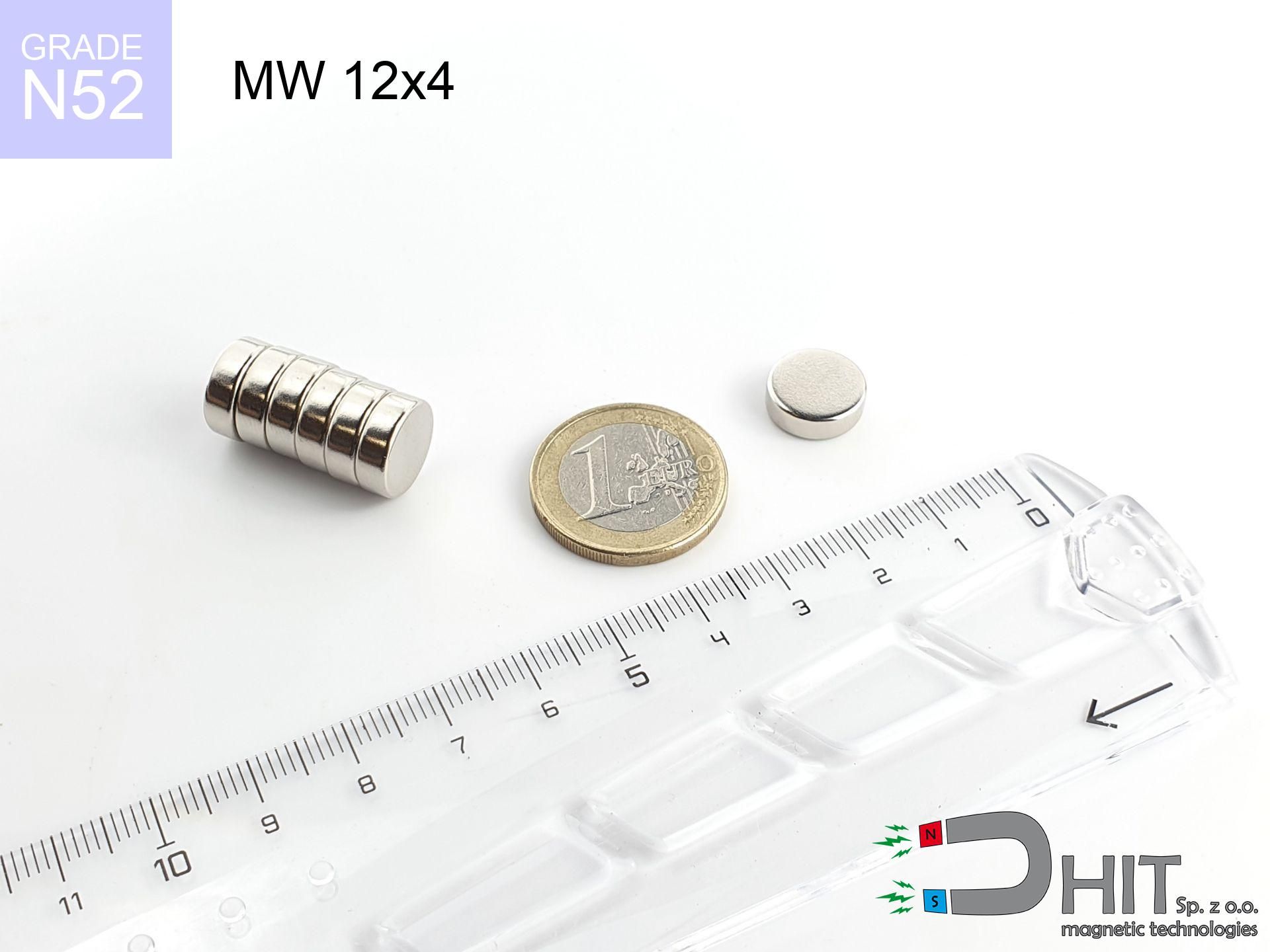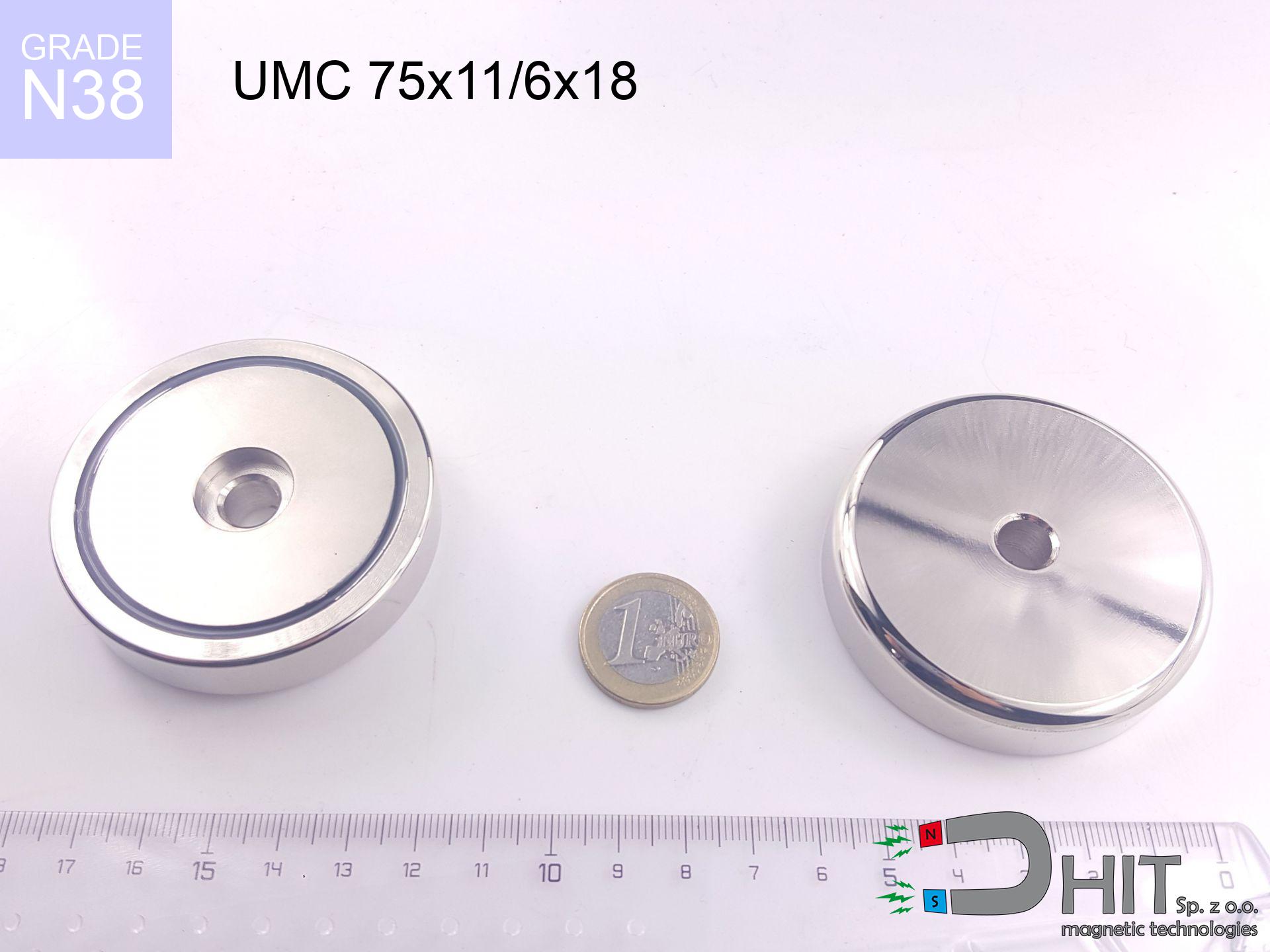MW 12x4 / N52 - neodymium magnet
cylindrical magnet
catalog number 010500
diameter Ø
12
mm [±0,1 mm]
height
4
mm [±0,1 mm]
magnetizing direction
↑ axial
capacity ~
3.60 kg / 35.30 N
magnetic induction ~
400.45 mT / 4,005 Gs
max. temperature
≤ 80
°C
catalog number 010500
diameter Ø
12 mm [±0,1 mm]
height
4 mm [±0,1 mm]
magnetizing direction
↑ axial
capacity ~
3.60 kg / 35.30 N
magnetic induction ~
400.45 mT / 4,005 Gs
max. temperature
≤ 80 °C
2.21 ZŁ gross price (including VAT) / pcs +
1.80 ZŁ net price + 23% VAT / pcs
bulk discounts:
need more quantity?Want to talk about magnets?
Call us tel: +48 888 99 98 98 or get in touch via form on the contact page. You can check the strength and the shape of neodymium magnets in our magnetic mass calculator magnetic calculator
Orders placed by 2:00 PM will be shipped on the same business day.
Specification: cylindrical magnet 12x4 / N52 ↑ axial
Magnetic properties of the material N52
Physical properties of sintered neodymium magnets Nd2Fe14B
Moreover, even though neodymium is a component of the strongest magnets, they are susceptible to corrosion in humid environments. For this reason, they are coated with a coating of gold-nickel to increase their durability. It's worth noting that NdFeB neodymium magnets are about 13% lighter than SmCo magnets and, despite their power, easily break, which requires special caution during their handling. For this reason, any mechanical processing should be done before they are magnetized.
In terms of safety, there are several recommendations regarding the use of these magnets. It is advisable to avoid their use in acidic, basic, organic environments or where solvents are present, as well as in water or oil. Additionally, they can damage data on magnetic cards and hard drives, although data deletion using a neodymium magnet is not guaranteed.
In terms of properties in different environments, neodymium magnets are sensitive to corrosion, especially in humid conditions. Therefore, they are often coated with coatings, such as nickel, to shield them from environmental factors and prolong their durability. High temperatures exceeding 130°C can cause a reduction of their magnetic strength, although there are specific types of neodymium magnets that can tolerate temperatures up to 230°C.
As for risks, it is important to avoid using neodymium magnets in acidic environments, basic conditions, organic or solvent environments, unless they are insulated. Additionally, their use is not recommended in wet conditions, oil, or in an environment containing hydrogen, as they may forfeit their magnetic strength.
Choose recommended products
Advantages as well as disadvantages of neodymium magnets NdFeB.
Apart from immense strength, neodymium magnets have the following advantages:
- They do not lose their power (of the magnet). After about 10 years, their strength decreases by only ~1% (theoretically),
- They are highly resistant to demagnetization by external magnetic field,
- Thanks to the shiny finish and nickel, gold, or silver coating, they have an aesthetic appearance,
- They exhibit very high magnetic induction on the surface of the magnet,
- Magnetic neodymium magnets are characterized by very high magnetic induction on the surface of the magnet and can operate (depending on the shape) even at temperatures of 230°C or higher...
- Due to the option of accurate forming and adaptation to individual needs – neodymium magnets can be produced in many variants of shapes or sizes, which amplifies their universality in usage.
- Significant importance in the industry of new technologies – find application in computer drives, electric drive mechanisms, medical apparatus and very modern machines.
Disadvantages of neodymium magnets:
- They are fragile when subjected to a powerful impact. If the magnets are exposed to impacts, we recommend using magnets in a metal holder. The steel housing in the form of a holder protects the magnet from impacts, and at the same time increases its overall strength,
- Magnets lose their strength due to exposure to high temperatures. In most cases, when the temperature exceeds 80°C, these magnets experience permanent reduction in strength (although it is worth noting that this is dependent on the form and size of the magnet). To avoid this problem, we offer special magnets marked with the [AH] symbol, which exhibit high temperature resistance. They can operate even at temperatures as high as 230°C or more,
- Due to their susceptibility to corrosion in a humid environment, we recommend using waterproof magnets made of rubber, plastic, or other moisture-resistant materials when using them outdoors,
- Limited ability to create threads or complex shapes in the magnet - the use of a housing is recommended - magnetic holder
- Possible danger associated with microscopic parts of magnets pose a threat, if swallowed, which is particularly important in the context of child safety. Furthermore, small elements of these products have the potential to hinder the diagnostic process after entering the body.
Safety Precautions
Neodymium magnets should not be around children.
Neodymium magnets are not toys. You cannot allow them to become toys for children. Small magnets pose a serious choking hazard or can attract to each other in the intestines. In such cases, the only solution is to undergo surgery to remove the magnets, and otherwise, it can even lead to death.
The magnet coating contains nickel, so be cautious if you have a nickel allergy.
Studies clearly indicate a small percentage of people who suffer from metal allergies such as nickel. An allergic reaction often manifests as skin redness and rash. If you have a nickel allergy, you can try wearing gloves or simply avoid direct contact with nickel-plated neodymium magnets.
Neodymium magnets are not recommended for people with pacemakers.
Neodymium magnets generate strong magnetic fields. As a result, they interfere with the operation of a pacemaker. This happens because such devices have a function to deactivate them in a magnetic field.
Dust and powder from neodymium magnets are highly flammable.
Avoid drilling or mechanical processing of neodymium magnets. If the magnet is crushed into fine powder or dust, it becomes highly flammable.
Keep neodymium magnets as far away as possible from GPS and smartphones.
Magnetic fields generated by neodymium magnets interfere with compasses and magnetometers used in navigation, as well as internal compasses of smartphones and GPS devices.
Magnets will attract to each other, so remember not to allow them to pinch together without control or place your fingers in their path.
In the case of placing a finger in the path of a neodymium magnet, in such a case, a cut or a fracture may occur.
Neodymium magnets can become demagnetized at high temperatures.
Despite the fact that magnets have been observed to maintain their efficacy up to temperatures of 80°C or 175°F, it's essential to consider that this threshold may fluctuate depending on the magnet's type, configuration, and intended usage.
Neodymium magnets are noted for being fragile, which can cause them to become damaged.
In the event of a collision between two neodymium magnets, it can result in them getting chipped. They are coated with a shiny nickel plating similar to steel, but they are not as hard. In the case of a collision between two magnets, there can be a scattering of small sharp metal fragments in different directions. Protecting your eyes is essential.
Keep neodymium magnets away from TV, wallet, and computer HDD.
The strong magnetic field generated by neodymium magnets can damage magnetic media such as floppy disks, video tapes, HDDs, credit cards, magnetic ID cards, cassette tapes, etc. devices. They can also damage devices like video players, televisions, CRT computer monitors. Do not forget to keep neodymium magnets at a safe distance from these electronic devices.
Comparing neodymium magnets to ferrite magnets (found in speakers), they are 10 times more powerful, and their strength can shock you.
Read the information on our website on how to properly utilize neodymium magnets and avoid significant harm to your body and unintentional disruption to the magnets.
In order to illustrate why neodymium magnets are so dangerous, see the article - How very dangerous are very strong neodymium magnets?.




![search holder 75x25 [M10x3] GW F200 GOLD Lina / N42 search holder 75x25 [M10x3] GW F200 GOLD Lina / N42](https://cdn3.dhit.pl/graphics/products/ump-75x25-m10x3-gw-f200-gold-lina-buh.jpg)


